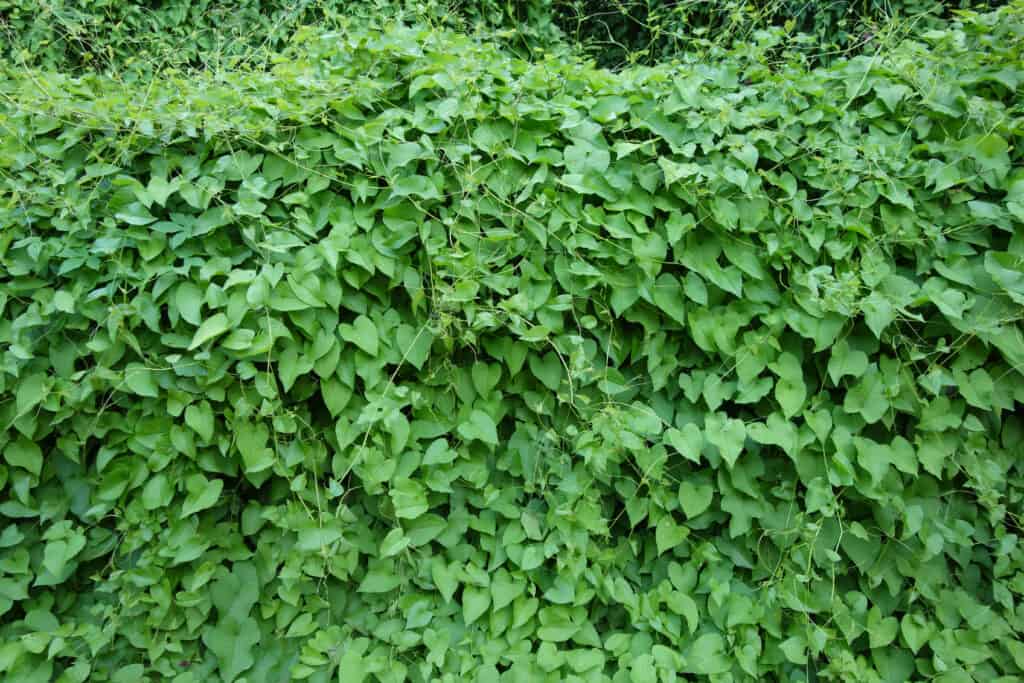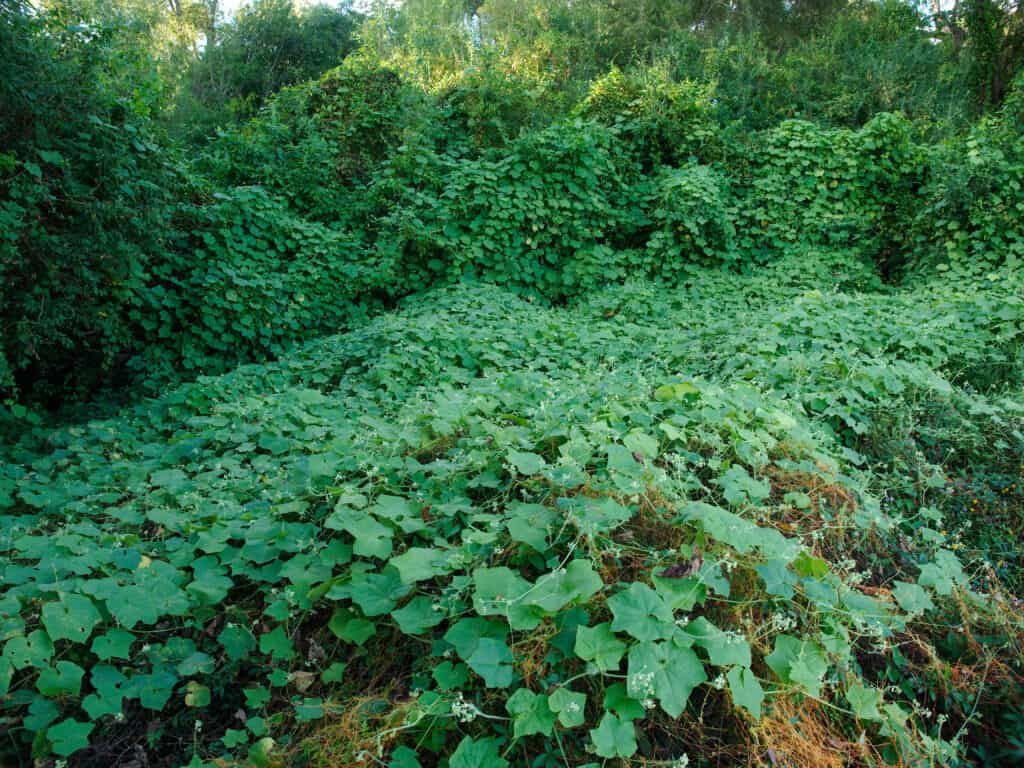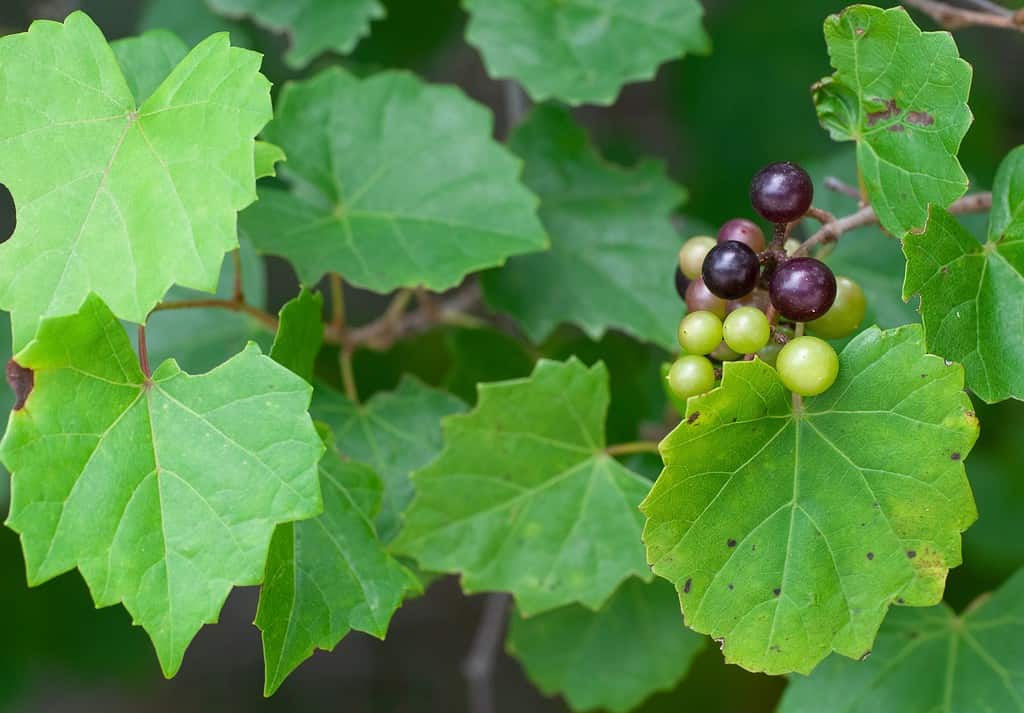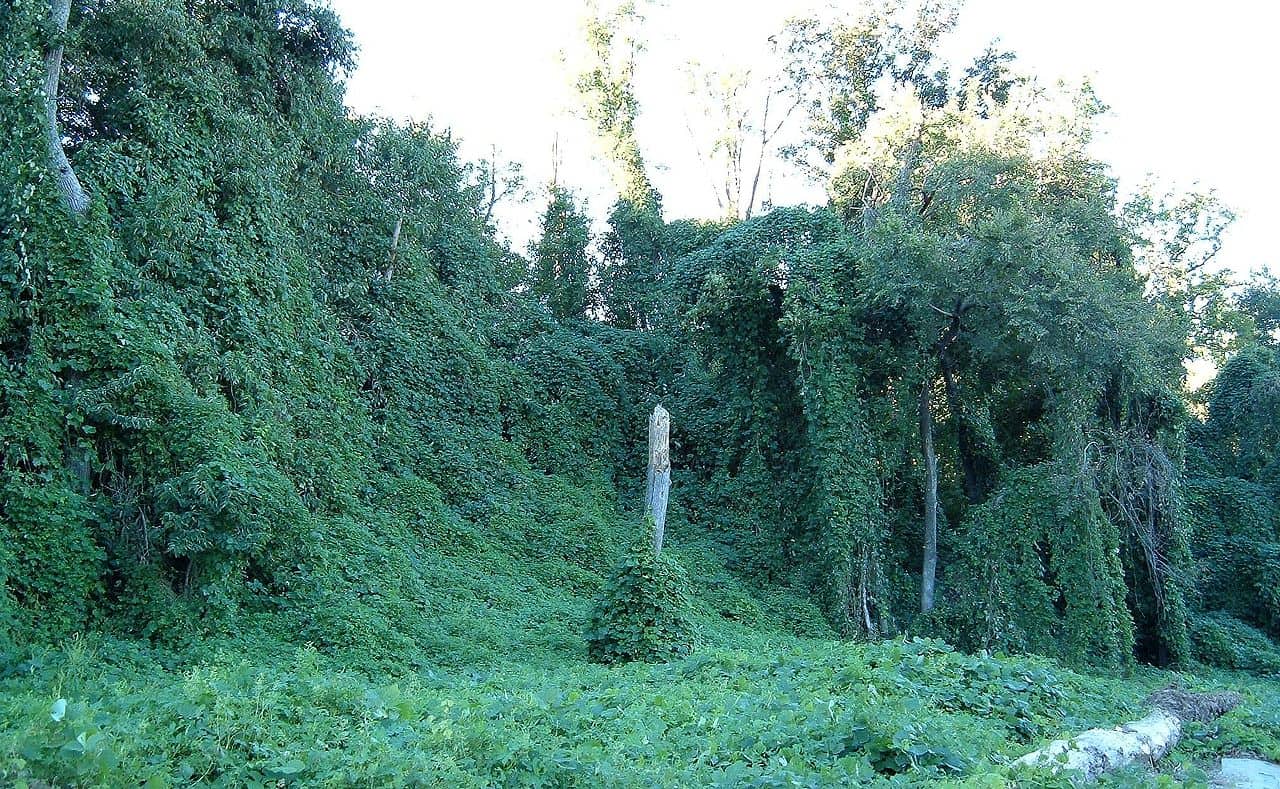If you live anywhere on the east coast of the United States, you have almost certainly come into contact with the kudzu vine. It, along with Chinese privet, is a widespread invasive and the focus of many eradication efforts.
This was not always the case, however. Existing colonies of kudzu can serve many uses while they are here. These uses can even contribute in little ways to control efforts in overgrown areas.
In this guide, we’ll talk about how kudzu became so prevalent in the United States, how to correctly identify it, and which parts of it are edible. We’ll also talk about how to tell it apart from some of its lookalikes.

Kudzu is widespread — particularly throughout the South.
©SATYAJIT MISRA/Shutterstock.com
| Botanical name | Pueraria montana |
| Common name | Kudzu |
| Grows in… | Along roadsides, old agricultural areas, and forests. Hardy in climate zones 3-7. Adaptable but does best where winters are mild and summers are hot and humid. |
| Edible? | Yes. All parts except seeds and seed pods. |
| Beginner friendly? | Considered invasive and is illegal to plant in many states. Do not plant. Forage wild kudzu. |
What is Kudzu?
Kudzu, or Pueraria montana in botanical terms, is a species of wood-like trailing vine that is closely related to beans and peas. It is native to East Asia and northern Australia, but it was intentionally introduced to the United States in the late 1800s.
Kudzu began to gain popularity as an ornamental shade plant after the Centennial Exposition in Philadelphia in 1876. It was often compared to wisteria and many gardeners began to plant it at home to cover outdoor spaces. Later on, in the early 1900s, the government subsidized the farming of over 1 million acres of kudzu in an attempt to prevent soil erosion. It also made for an effective forage crop for livestock.
In the present day, kudzu has expanded its range as far north as Canada and there are also reports of it appearing on the west coast. As of 2019, it has formed colonies in at least 30 states in America. Overall, however, it is the most prevalent in the hot and humid southeast.
Defining Characteristics of Kudzu
At this point, kudzu colonies are covering large swaths of land, and they are pretty hard to miss. They grow off the sides of many major roadways, oftentimes covering everything in view.
Although kudzu is very conspicuous once it has formed large colonies, individual plants can easily blend into their surroundings. If you’re interested in working to remove it from ecosystems or just want to prevent further spread, identifying kudzu throughout its life cycle is a crucial skill.
The information below regarding its physical characteristics as well as its growth habit and reproductive strategies will help you pick individual plants out of the crowd.

Kudzu is a fast-growing invasive vine.
©Roberto Michel/Shutterstock.com
Growth Habit
Kudzu is well known for its incredibly aggressive rate of growth. Since its introduction in the 19th century, kudzu has managed to engulf over 7 million acres of land in the southern United States alone. Each vine can grow about a foot per day, reaching lengths of up to 100 feet in just a couple of growing seasons. If you see an expansive, monocultural growth of vines, it is likely kudzu.
Vines
These plants are capable of producing up to 30 vines from a single root crown. Vines start tender and green, but over time become hard and wood-like, reaching thicknesses of up to 4 inches. Not only do they grow quickly, but they also climb, forming a heavy, tangled mass that is difficult to remove. These vines will eagerly scale trees, buildings, telephone poles, and anything you can think of. In storms, the additional plant mass can cause tall trees and poles to fall over.
Vine tips are edible when tender and green and are comparable to asparagus when cooked. Older vines become too hard and fibrous to eat, however. Make sure to harvest only the growing tips.
Leaves
Kudzu leaves appear alternately along vines and consist of three leaflets. Each of these wide leaflets is hairy at the edges and is usually lobed (but may not be). The plant is deciduous and will begin to drop its leaves as autumn approaches. New leaves emerge in the spring and early summer as the plant ends its dormancy and enters its growing season.
Young leaves of this plant are edible and make for delicious salad greens. Older ones become fibrous, however, and are better cooked. They can also be simmered to make a nutritious herbal tea, or wilted and treated like collard greens or spinach. They can even be added to quiches and casseroles.
Flowers
The small, purple flowers of the kudzu plant appear in clusters in late summer. They are particularly fragrant, producing a scent that is reminiscent of grape-flavored candy. This scent is easily detectable from a distance and is a great identifying trait to pay attention to during the summer months. You will likely have to look upward to see them, however, as they tend only to appear on vines that are growing vertically. Lower, lateral vines do not often flower.
In addition to the leaves and vine tips, kudzu flowers are also edible raw or cooked and make for tasty floral jams, teas, and syrups.
Seed Pods
Kudzu seed pods are very distinctive. They are brown and flat and are covered in hairs, and appear subsequently to the late summer flowers. Each pod can contain up to 10 hard, brown seeds. Unlike other parts of the kudzu plant, the seeds and seed pods are tough and inedible at all stages.
Roots
Once established, kudzu is extremely difficult to remove. This is partially because kudzu plants form extremely stout and deep-growing tuberous roots. These swollen, starchy roots serve as nutrient stores that the plant can access in times of emergency or scarcity. Many plants, like cassava and cucumbers, also form tuberous roots. However, they take a fairly long time to reach a considerable size. Kudzu, on the other hand, is capable of producing robust storage structures at a relatively quick pace. Some of these roots, once mature, can weigh up to 400 pounds. Because it can generate and draw from such a wealth of resources, kudzu can easily recover from droughts and freezes, as well as aggressive removal efforts.
If, during foraging, you unearth some kudzu roots, they can be treated just like any edible root vegetable. Peel the outer skin off of them and roast or boil them to soften them up. They are starchy and similar in texture to a potato and are delicious with similar seasonings.
How Does Kudzu Reproduce
Kudzu reproduces in multiple ways, which is another reason why it can take over areas so quickly.
As each vine traverses its environment and climbs over obstacles, it will almost certainly come into contact with the ground at many points. At each of these points, it can produce adventitious roots that take hold in the soil. Each of these new rooting points can eventually produce its tuberous root base and become its independent plant.
Because kudzu expands so rapidly, it is very successful at dispersing its seeds. As vines approach and overhang waterways, they can easily distribute their seeds downstream. The seeds are also valuable forage for birds and mammals, which help move them around.
Although seeds are easily disseminated, they do not readily germinate on their own. To create a new plant, a seed’s outer coating must be sacrificed or damaged. This can take place in a variety of ways. As seeds brush against rocks and other foliage on the forest floor, their coats will abrade. Acidic environments may also wear away at the seed coat over time.
Kudzu seeds may also germinate amidst even the most aggressive control efforts, as they may survive fires that other plants do not. It is possible that burning seeds can serve to damage their coating and allow them to germinate.
Kudzu Lookalikes
If you’re not familiar with this plant, it can be easy to mistake it for other pea relatives and native vining plants. The following plants also grow in areas where kudzu has established itself. You’ll want to make sure that you can distinguish between them as well.
Hog Peanut (Amphicarpaea bracteata)
This North American vining plant has a very wide native range. It begins northwards in Manitoba and Nova Scotia, extending as far south as Florida and Texas and into parts of the Midwest.
Like Kudzu, the hog peanut belongs to the pea family, Fabaceae. It produces compound leaves made up of three leaflets that appear along hairy stems. Unlike kudzu, however, the vines of the hog peanut are soft and herbaceous and climb by wrapping themselves around other plants and support structures. Its vines are also significantly shorter and appear only annually, whereas kudzu’s lengthy vines are perennial and harden with age.
The flowers of the hog peanut are also unique from those of the kudzu vine. While kudzu plants will usually only flower from their vertical vines, hog peanut vines will produce two different types of flowers depending on their orientation. Vines that climb vertically will produce flowers that resemble those of other pea-family plants, including kudzu. Lateral vines, however, produce an inconspicuous and specialized type of flower. These flowers are self-fertilizing and do not open. Instead, they produce seed pods that bury themselves under the ground like the familiar, but distantly related, peanut plant (Arachis hypogaea).
Muscadine Grape (Vitis rotundifolia)
The muscadine is an edible species of wild grape that is native to the southeastern United States. In the summer, they produce large, green, or deep purple grapes that have thick skins. Green muscadines tend to be more tart than their purple counterparts.

The Wild Muscadine grapevine,
Vitis rotundifolia, is often mistaken for kudzu.
©Donna Bollanbach/Shutterstock.com
Vines of this plant will climb many feet in the air if they are well supported and produce panicles of white flowers in the spring. Their leaves are broad and green but are distinct from those of the kudzu vine in that they appear singly and have blunt-toothed margins rather than lobes.
It is very easy to distinguish between muscadine vines and kudzu vines when they are bearing leaves, fruit, and flowers. In the late fall and winter seasons, however, the bare vines can look similar. They both climb and are tough and semi-woody. They also grow well in the same areas along wood lines and forests and in places where they can rise above ground level. If you’re concerned that you may have a kudzu infestation on your hands, it can be best to wait until new growth emerges in the spring before attempting removal.
Ticktrefoil (Desmodium canadense)
The tick-trefoil plant also belongs to the pea family. It produces flowers that look similar to those of kudzu but has an erect growing habit rather than a vining one. You can distinguish between young plants with fewer defining features by examining the stems and leaves. Young kudzu vines will have hairy stems while tick-trefoil stems will not. Mature stem length is also significantly shorter. Tick-trefoils will reach heights of only 4–5 feet in ideal conditions. Many will not grow this tall.
Examining leaf shape is the quickest way to distinguish between the two species. Kudzu leaves are hairy and compound, producing groups of three wide leaflets. Each leaflet is ovular or heart-shaped and sometimes lobed. Tick-trefoil leaves, while still compounded in groups of three, are long and narrow with rounded tips. They typically grow twice as long as they are wide.
Thank you for reading! Have some feedback for us? Contact the AZ Animals editorial team.








